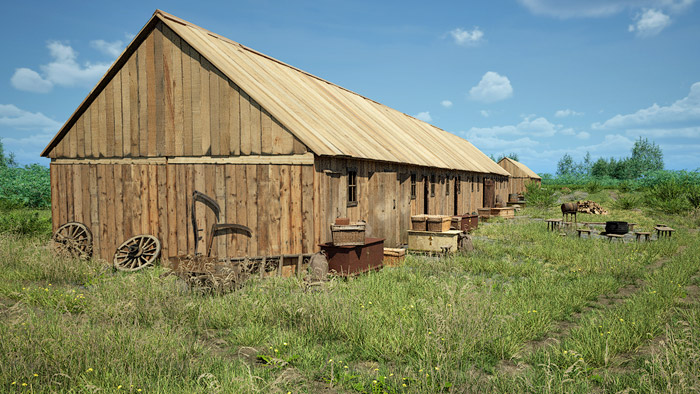The relief felt by the first Mennonites upon arrival at the immigration sheds in August 1874 morphed into disappointment when they realized there was no reliable water supply. In June, Jacob Shantz had intentionally positioned the sheds near a shallow pool likely fed by a spring (no longer active today), but it had largely dried up by mid-August. Digging shallow holes and using the water that gradually filled them was unsatisfactory, and as a dry August continued, they were left to haul water from the river. A decision was then made to dig a deep well between the two eastern sheds. Today we know that in the 1870s water could only be found past 60 feet, but assuming their experience in Imperial Russia to be normative, they believed they would strike water not much more than half that far down. Not familiar with the type of loose Emerson soil here, they neglected to shore up the sides of the shaft, and on August 15(1) when they reached 40-45 feet the well caved in on Johann Hiebert 18, and Johann Reimer 24, burying them up to their necks. Afraid that any further movement might dislodge even more soil and bury them completely, the men above momentarily stood frozen in indecision, hearing the faint cries for help, but afraid to do anything that might make things worse. Reimer’s wife Helena tried to jump in to help her husband and had to be restrained. She fainted.
Time was short, for the two men would soon die of asphyxiation. Boards were hurriedly placed to prevent more earth from sliding down. One man quickly volunteered to be lowered over 35 feet into the well on a rope held by the others and attempt to dig them out. He dug around them with his spade until they could be hauled up, unconscious but alive. Hiebert had significant internal injuries, for he had just been bending over his shovel when the cave-in happened. Reimer suffered a broken leg. Doctor Hanson was brought to the site from Winnipeg a day later to examine both and to set the leg. Both men survived after some convalescence, although Hiebert was somewhat less than robust for the rest of his life. The well remained dry, and water was so scarce some immigrants moved back to the banks of the Red River. The accident fueled even more discontent.
The 28-year-old Old Colony man who kept his head and became a rock in the crisis, was suitably named, Peter Redekopp. He had arrived on the International on August 1st with the Kleine Gemeinde. “Peter” comes from the old word Petros, which means “rock”, a word Jesus used to rename the Apostle Peter. Even more significant, however, is his family name. Redekopp is composed of two Dutch words: “raad” meaning wise counsel and “kop” – meaning head, and in Low German is pronounced Raadekopp this day. Combined, the two parts of the name signify a person known to have his head in the right place. Coincidentally, on August 15, 1874 just such a level-headed person was present who, at great personal risk, simply did what had to be done, and changed a potential tragedy into a courageous pro-active rescue. Although the incident did not assuage the discontent, looking back now, there is a profoundly symbolic aspect to the coincidence that the very name of the man so aptly mirrors what happened. And that today the focus is not on the accident itself, but on the rescue, which represents a pivotal moment in the first days of settlement, and symbolized exactly what it would take to survive in this new land.




